Gardeners may already have the basic idea on how to grow rhubarb from crowns or divisions. However, if you intend to go for a huge rhubarb patch the soonest possible time without having to spend a lot, growing rhubarb from seed is the way to go. Rhubarb’s stems grown from seed won’t have the usual loud red hue. Some stems would be red, but some will have the shade of green. However, the rhubarb taste will just be the same. Should you prefer the stalks to be all red, grab some divisions from your neighbor or friend, or you can freely buy it from the nearest nursery.

Fresh Rhubarb stalks ready to be sold at the farmer’s market
Tips And Guidelines When Growing Rhubarb Plant
As you start your seeds, do take note that rhubarb is a form of cool-weather plant. So, consider the following:
- For cooler climate zones (zone 6), it’s just a simple-to-grow perennial (usually planted where there’s outdoor privy). Its leaves and stalks just die-back with the very first frost during the fall season. However, the plants would just come back as soon as the spring begins.
- For zones 7 and 8, it would be rather difficult to grow rhubarb from seed in your backyard garden. The growth will just be short-lived. Extra caution has to be practiced to protect the rhubarbs from intense summer heat. During summer, it’s ideal to pick a location with a good afternoon shade. The north area of your grape arbors, raspberry patches, or asparagus ferns will be great spots.
- For areas with extreme summer season (Zones 9 and 10), growing rhubarb from seed is possible as a winter annual.
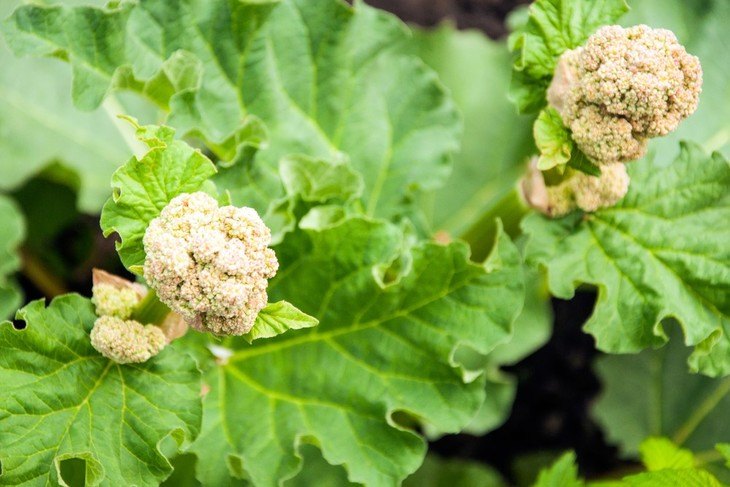
A rhubarb flower usually blossoms in spring
Rhubarb Seeds: The Starting Point
Rhubarb seeds are usually encased in a huge shell that resembles a paper. In order to expedite germination, you need to soak the seeds in water for around 1 to 2 hours prior to planting them. If you are doing it indoors, plant your seeds in a screened compost or some other alternative organic planting mixture. Start with 2 seeds for every 2-3-inch pot. If you want to make transplanting easier, then make use of cow pots or peat pots.
If you’re working on spring plantings, using a mat or a heating cable would speed up the germination as long as the room temperature does not go beyond 70°F. Keep the seedlings evenly moist. However, do not over-water, for the seedlings may not survive the root rot due to excessively moist ground.
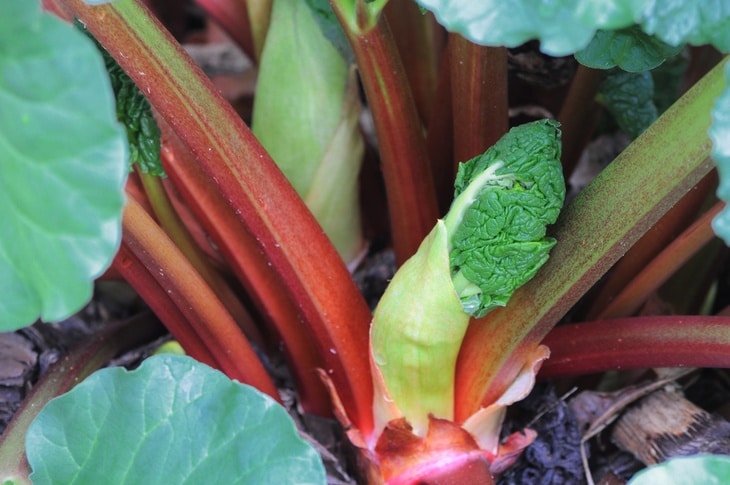
A budding flower of a rhubarb plant amid the spring
Growing Rhubarb From Seed: Perennial
For those in zones 8 and below, start growing rhubarb in spring. Sow the seeds in flats or pots and keep them covered for 8 to 10 weeks prior to the frost. The plant should be around 4 inches in length. Cover your seedlings with mulch to keep the soil’s moisture level even and the roots cool. To take the mulch off, you can use a mulcher vacuum. Before your transplant, harden the plants off first. You may also just secure the new transplants using row cover until the frost passes.
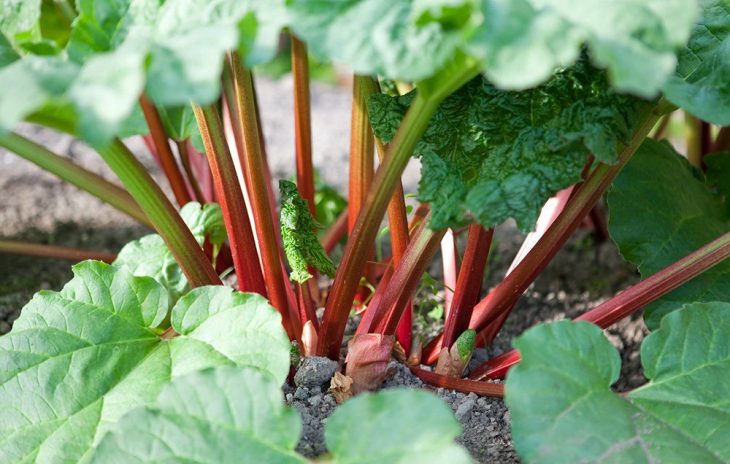
Well-cared rhubarb plants can beautifully grow in the backyard
Growing Rhubarb From Seed: Annual
To start growing rhubarb as an annual during winter and fall (zones 9 and above), set the seeds in a cool location. It could be a shady outdoor spot or a bright indoor area. Do this from late August through early October. As the seedlings become at least 4-inch tall, you may start transplanting them in your garden. The plants would then be good to harvest by March or May. Do not wait for summer before you harvest your plants, or else, they won’t survive the summer heat. You can only go for this technique if the winters are just mild. If you could just protect your plants from frost using row cover or cold frame, this technique could work just fine as well.
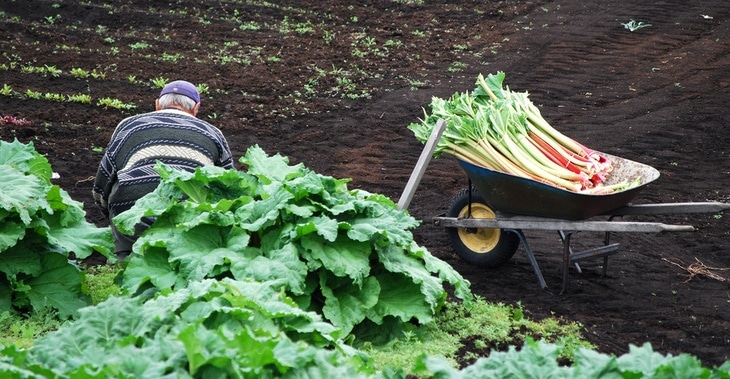
A farmer ready to harvest his heaps of rhubarb plants
Harvesting Rhubarb
You can harvest rhubarb by pulling or cutting off its leaf stalks. If your rhubarb have ten stalks, you could harvest three or four stems at a time for each plant. When you’re growing rhubarb from seed as an annual, do harvest the whole plant. Take note to use only the stalks. Don’t try to eat the leaves of the rhubarb as they have high levels of the toxic chemical called oxalic acid.
As for perennial plantings, just let some of the leaves stay on the plants in the summer in order to generate some energy reserve for the next year. It’s recommended to harvest just a few stems at a time– in fall and spring only. Do not stress the rhubarbs during the summer season. Do not harvest them during seasons of extreme heat. Moreover, frost is not good for the leaves. Thus, harvest them just before the frost comes, ideally in fall.
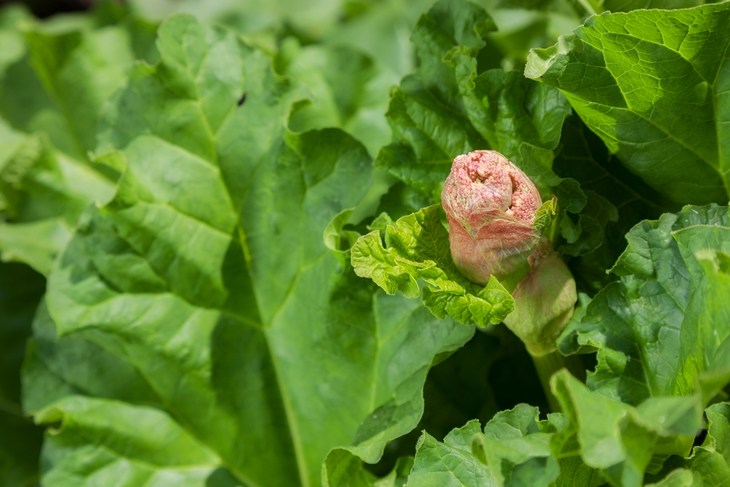
Harvest rhubarb plants during cool seasons
Conclusion
Breaking off and discarding flowering stalks right at ground level are recommended. These flowering stalks are not good for eating. Breaking these flowering stalks off prevents your plant from allocating energy into the seeds and flowers.
Also, do not harvest in the initial year if you’re still developing a perennial bed. As for annual beds, harvest all the rest of the stalks if the weather starts to get scorching hot in the summer. Don’t forget to take care of your garden well.
Do you want to grow rhubarb plant from seeds? Hope this article helps you get started. Thank you for reading!
You might like this:
- How to Protect Your Grass Seeds from Birds in 2 Fail-safe Ways
- How To Have Fast-Growing Grass Seed? Steal These 5 Effective Tips!
Pin it!
